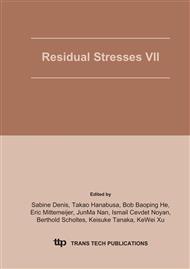[1]
J Black, G Hastings. handbook of biomaterial properties. London: Chapman & Hall, (1998).
Google Scholar
[2]
R Boyer, G Welsch, EW Collings. Materials properties handbook: titanium alloys. Ohio: ASM international (1994).
Google Scholar
[3]
T Alberktsson, B Alberltsson. Acta Orthop Scand Volume 58(1987)567.
Google Scholar
[4]
IMO Kanagasbiemi, CCPM Verheyen, et al. J Biomed Mater Res Volume 28(1994)563.
Google Scholar
[5]
K Takatsuka, T Yamamuro, T Makamura, T Kokubo. J Biomed mater Res Volume 29(1995)157.
Google Scholar
[6]
RM Urban, JJ Jacobs, DR Sumner, CL Peters, et al. J Bone Jt Surg Volume 78(1996)1068.
Google Scholar
[7]
B Koch, C Wolke, K Groot. J Biomed Mater Res Volume 24(1990)655.
Google Scholar
[8]
L Ellies, D Nelson, J Featherstone. Biomaterials, Volume 13(1992)313.
Google Scholar
[9]
R Whitechead, W Lacefield, L Lucas. J Biomed Mater Res Volume 27(1993)1501.
Google Scholar
[10]
H Ji, P Marquis. Biomaterials, Volume(1993)64.
Google Scholar
[11]
Z Zyman, J Weng, X Liu, X Li, X Zhang. Biomaterials, Volume (1994)151.
Google Scholar
[12]
K. Ando, K. Matsumura, Thin Solid Films Volume 52(1978)153.
Google Scholar
[13]
P. Kurze, W. Krysmann, J. Schreckennach, Th. Schwarz., K. Rabending. cryst. Res. Technol. Volume 22(1987)53.
DOI: 10.1002/crat.2170220115
Google Scholar
[14]
V. Maqlyschev. OberflachentechniK Volume 49(1995)606.
Google Scholar
[15]
J. Schreckenbach. metalloberflache Volume 45(1991)437.
Google Scholar
[16]
J. Tian, Z. Luo, S. Qi, X. Sun, Surf. Coat. Tech. Volume 154(2002)1.
Google Scholar
[17]
S. Carlsson, P L Larsson. Acta Mater. Volume 49(2001)2193.
Google Scholar
[18]
Y Han, KW Xu, J Lu. J. Biomed. Mater Res. Volume 45(1999)198.
Google Scholar
[19]
O. Zywitzki, et. al. E-MRS Spring Meeting 2003, Symposium G: Protective coatings and thin films Strasbourg, France, June 10 - 13, (2003).
Google Scholar
[20]
B He. Powder Diffraction Volume 18(2003)71.
Google Scholar


